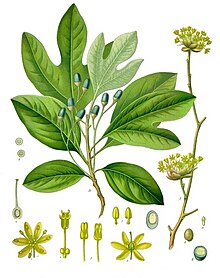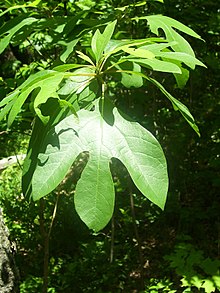Sassafras tree
| Sassafras tree | ||||||||||||
|---|---|---|---|---|---|---|---|---|---|---|---|---|

Sassafras tree ( Sassafras albidum ) |
||||||||||||
| Systematics | ||||||||||||
|
||||||||||||
| Scientific name | ||||||||||||
| Sassafras albidum | ||||||||||||
| ( Nutt. ) Nees |
The sassafras tree ( Sassafras albidum ), also known as the fennel wood tree or the cinnamon tree, is a species of the laurel family (Lauraceae). It is widespread in eastern North America .
description
Vegetative characteristics
Sassafras albidum grows as a deciduous tree and reaches heights of 20 to 35 meters. The bark is grayish to brownish, thick and, in older trees, also furrowed. The stem-round branches have a light green bark with dark olive spots.
The alternately arranged leaves are shaped very differently. The leaf blade is with a length of 10 to 16 centimeters and a width of 5 to 10 centimeters in outline ovate to elliptical and unlobed or two to three, rarely multi-lobed with a blunt to pointed upper end . The three-lobed leaf blade is vaguely reminiscent of a fig leaf. The leaf margin is whole. The upper side of the leaf is fresh green and the underside of the leaf is blue-green and bare. In autumn the leaves turn yellow to orange or purple in color. The nerve is threefold.
Generative characteristics
The flowering time in spring is usually between April and May. Sassafras albidum is dioeciously segregated ( diocesan ). Several flowers stand together in clusters or paniculate inflorescences that are up to 5 centimeters long and have silky, downy hairs. The bracts are up to 1 centimeter long.
The relatively small, sweet-lemon-scented, bare and stalked flowers are functionally unisexual with a simple flower envelope . The six petaloid bracts are greenish-yellow. In the male flowers there are three circles with three stamens each, the inner circle each having two clearly stalked glands at the base of the thin stamens . A sterile pistil may also be present in the top flower of a male inflorescence . Female flowers contain six short staminodes and an upper ovary with a slender 2 to 3 millimeter long stylus that ends in a cephalic stigma .
The more or less fleshy “ fruit cup ” is reddish. The blue-black and single-seeded, smooth stone fruits when ripe are ovoid and up to 1 centimeter long.
The number of chromosomes is 2n = 48.
Occurrence
In eastern North America , Sassafras albidum occurs in Ontario and in the US states: Alabama , Arkansas , Connecticut , Delaware , Washington DC , Florida , Georgia , Illinois , Indiana , Iowa , Kansas , Kentucky , Louisiana , Maine , Maryland , Massachusetts , Michigan , Mississippi , Missouri , New Hampshire , New Jersey , New York , North Carolina , Ohio , Oklahoma , Pennsylvania , Rhode Island , South Carolina , Tennessee , Texas , Vermont , Virginia , West Virginia in front. There are also occurrences in the Venezuelan jungle.
Sassafras albidum thrives in different habitats : forests , erosion areas , fallow land and ruderal areas at altitudes between 0 and 1500 meters.
Systematics
This species was first validly described in 1818 under the name Laurus albida by Thomas Nuttall in The Genera of North American Plants , 1, pp. 259-260 . The currently valid name Sassafras albidum was published in 1836 by Christian Gottfried Daniel Nees von Esenbeck in Systema Laurinarum , p. 490.
Further synonyms are: Laurus sassafras L. , Sassafras albidum var. Molle (Raf.) Fernald , Sassafras officinalis T.Nees ex CHEbermaier , Sassafras sassafras (L.) H. Karsten , Sassafras variifolium Kuntze . Varieties have been described which differ, for example, in hairiness, but the validity of these varieties is not clear.
use
Sassafras oil , which contains 80% safrole and is used as a perfume and flavor , can be obtained from the root bark and the fruits by steam distillation . The root bark was also used to make root beer before it was banned. Some indigenous peoples of North America used the branches as chewing sticks. Sometimes ingredients from the root bark are used in toothpaste . Filé powder is extracted from the dried leaves , which is used as a spice and binding agent in Cajun cuisine .
Safrol also supplies a raw material for the production of MDMA ( Ecstasy ), so the trade in extracts from Sassafras is prohibited in the EU. In Switzerland, sassafras oil and safrole are so-called precursors that can be used to manufacture narcotics and psychotropic substances . The purchase is subject to authorization and the use of more than 10 g per year leads to an official control obligation within the meaning of the Narcotics Control Ordinance.
Safrole is said to have hallucinogenic effects and cause contact dermatitis , especially in higher doses ; in addition, it is said to cause carcinomas and to be hepatotoxic .
swell
- Henk van der Werff: Sassafras. : Sassafras albidum - online with the same text as the printed work , Flora of North America Editorial Committee (Ed.): Flora of North America North of Mexico. Volume 3: Magnoliophyta: Magnoliidae and Hamamelidae , Oxford University Press, New York and Oxford, 1997, ISBN 0-19-511246-6 . (Sections Description, Occurrence and Systematics).
Web links
- Fennel tree at Baumkunde.
- Sassafras tree - Sassafras albidum on feenkraut.de.
- Sassafras albidum at Useful Temperate Plants.
Individual evidence
- ^ Sassafras albidum at Tropicos.org. Missouri Botanical Garden, St. Louis
- ↑ a b c d Henk van der Werff: Sassafras. : Sassafras albidum - online with the same text as the printed work , Flora of North America Editorial Committee (Ed.): Flora of North America North of Mexico. Volume 3: Magnoliophyta: Magnoliidae and Hamamelidae , Oxford University Press, New York and Oxford, 1997, ISBN 0-19-511246-6 .
- ↑ Directory f: “Precursors” of the Narcotics Directory Ordinance. (PDF; 237 kB) In: Systematic collection of federal laws. Retrieved February 21, 2012 .
- ↑ Art. 5 Ordinance on Narcotics Directory. In: Systematic collection of federal laws. Retrieved February 21, 2012 .
- ↑ Narcotics Control Ordinance. (PDF; 292 kB) In: Systematic collection of federal laws. Retrieved February 21, 2012 .








